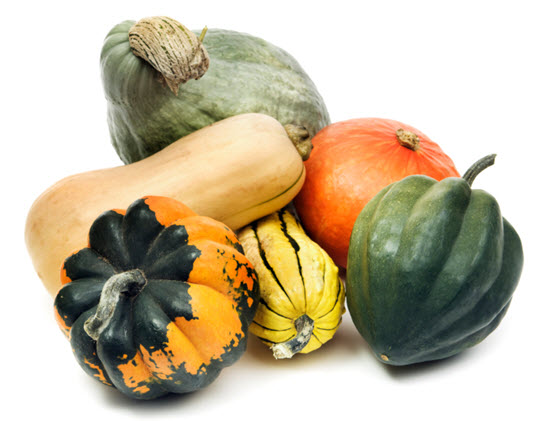
It”™s squash season! Winter squash — almost all of them — are among my favorite foods. They”™re an excellent source of starchy carbs, which are necessary for training, and don”™t add the undesirable elements of sugar or gluten.
People ask how I cook squash, and my answer is shocking but true. I microwave. (As mentioned in previous posts, I”™m a lazy cook but determined to eat healthful foods.) One safety note: larger squash, such as butternut, can be difficult to cut when raw. Most roasting/baking instructions require cutting the squash in half before placing it in the oven, so be careful. If you decide to be lazy like me, you can microwave without cutting first.
Acorn squash seems to be everywhere these days. It can be eaten as part of a quick pre-training meal. The meal could include any protein source you choose, from dinner leftovers to vegetable protein powder. Reheat the acorn squash, if desired, and top it with some raw, organic coconut oil. It”™s a fast, healthy meal and can get you through a tough workout.
Stuffed acorn squash makes a nice dinner side dish. You can, of course, use virtually anything you like to stuff it. One combination I”™ve played with is brown rice, wild rice, chopped vegetables, and pine nuts. If you go easy on seasonings, this could also serve as part of the pre-training meal above.
Another terrific squash is delicata. It can be substituted for acorn squash in either dish above and offers a little variety.
And how about spaghetti squash? It can be eaten just like any other squash, seasoned whichever way you prefer. But it also has that added fun-factor because it can be used exactly like spaghetti and topped with your favorite sauce to make a gluten-free “pasta.”
My favorite squash dish combines two winter standards. Butternut has a fantastic flavor but is often watery. Kabocha (aka Japanese pumpkin) has a drier, firmer texture but tastes bitter. Combining the two is easy. Cook both, let them cool, and discard the seeds. Scoop out the squash from each one, place it in a bowl, and use a potato masher to blend them. It”™s really quick. Pour out the water from the butternut squash as necessary.
The taste of this combo is good enough to be eaten plain with no seasoning. But, obviously, you can season it if you want, with any seasonings you choose.
Whether you already like squash or try it for the first time it this season, you might miss it (as I sometimes do) the rest of the year. Here”™s one way around that. A few years ago, I discovered canned, organic pumpkin. Look for a brand that contains pumpkin and absolutely nothing else. You can treat it exactly the way you would oatmeal or quinoa in my no sugar, no-bonk breakfast suggestion from a previous post. Season it according to your preference. I tend to use cinnamon at breakfast, but sea salt, freshly ground pepper, allspice, nutmeg, curry, and many other seasonings can work quite well anytime. If you stock up on several cans, you”™ll have it year-round.
My plan this year is to try some of the squash varieties I”™ve never tried before. If you have a favorite recipe, please feel free to pass it along to us. And please let me know how squash works as part of your pre-workout meal.
- New Year’s Resolutions: A Sugar Addict’s Survival Guide - April 15, 2024
- Motivation vs. Enthusiasm - October 12, 2023
- Why Exercise Shouldn’t Be Just One Thing - November 9, 2022
